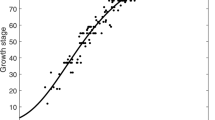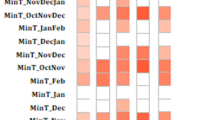Abstract
Bacterial ring rot (BRR) is a regulated disease of potato caused by the gram-positive bacterium Clavibacter michiganensis subsp. sepedonicus. Many countries have seed certification programs that involve pre- and post-harvest inspections for disease symptoms supplemented by laboratory immunological and nucleic acid diagnostics. Several studies have shown that environmental factors and other parameters may affect the severity of BRR symptoms. Collection and analysis of field data from 154 cultivated potato genotypes over 15 years indicates that moisture, temperature, and cultivar are major factors influencing BRR symptom expression. Sensitivity analysis showed that late season temperatures were more important than mid-season moisture. Contrary to expectations, cultivar susceptibility was of less importance in our models than weather parameters in determining BRR symptoms. A neural network model was successfully deployed that predicts severity of BRR symptom expression based on late season temperature, precipitation, and cultivar susceptibility.
Resumen
La pudrición anular bacteriana (BRR) es una enfermedad regulada de la papa causada por la bacteria gram positiva Clavibacter michiganensis subsp sepedonicus. Muchos países tienen programas de certificación de semillas que involucran inspecciones pre y post-cosecha para síntomas de la enfermedad, suplementados con diagnósticos inmunológicos y de ácidos nucleicos de laboratorio. Varios estudios han demostrado que los factores ambientales y otros parámetros pudieran afectar la severidad de los síntomas de BRR. La colección y análisis de datos de campo de 154 genotipos de papa cultivada durante 15 años indica que la humedad, temperatura y la variedad son los factores principales influenciando la expresión de síntomas de BRR. Análisis de sensibilidad mostraron que las temperaturas al final del ciclo fueron más importantes que la humedad a la mitad del ciclo. Contrario a las expectativas, la susceptibilidad varietal era de menor importancia en nuestros modelos que los parámetros meteorológicos en la determinación de los síntomas de BRR. Se instaló con éxito un modelo de red neural que predice la severidad de la expresión de los síntomas con base en la temperatura al final del ciclo, precipitación y susceptibilidad varietal.




Similar content being viewed by others
References
Bentley, S.D., C. Corton, S.E. Brown, A. Barron, L. Clark, J. Doggett, B. Harris, D. Ormond, M.A. Quail, G. May, D. Francis, D. Knudson, J. Parkhill, and C.A. Ishimaru. 2008. Genome of the actinomycete plant pathogen Clavibacter michiganensis subspecies sepedonicus suggests recent niche adaptation. Journal of Bacteriology 190: 2150–2160.
Bishop, A.L., and S.A. Slack. 1987. Effect of cultivar, inoculum dose, and strain of Clavibacter michiganense subsp. sepedonicum on symptom development in potatoes. Phytopathology 77: 1085–1089.
Bonde, R., and M. Covell. 1950. Effect of host cultivar and other factors on pathogenicity of potato ring-rot bacteria. Phytopathology 40: 161–172.
Bugbee, W.M., N.C. Gudmestad, G.A. Secor, and P. Nolte. 1987. Sugar beet as a symptomless host for Corynebacterium sepedonicum. Phytopathology 77: 765–770.
Danhorn, T., and C. Fuqua. 2007. Biofilm formation by plant-associated bacteria. Annual Review of Microbiology 61: 401–422.
De Boer, S.H., and S. Slack. 1984. Current status and prospects for detecting and controlling bacterial ring rot of potatoes in North America. Plant Disease 68: 841–844.
De Boer, S.H., A. Wieczorec, and A. Kummer. 1988. An ELISA test for bacterial ring rot of potato with a new monoclonal antibody. Plant Disease 72: 874–878.
Dykstra, T.P. 1941. Results of experiments in control of bacterial ring rot of potatoes in 1940. American Potato Journal 18: 27–55.
Ehret, D.L., D.B. Hill, D.A. Raworth, and B. Estergaard. 2008. Artificial neural network modelling to predict cuticle cracking in greenhouse peppers and tomatoes. Computers and Electronics in Agriculture 61: 108–116.
Hill, B.D., S.M. McGinn, A. Korchinski, and B. Burnett. 2002. Neural network models to predict the maturity of spring wheat in western Canada. Canadian Journal of Plant Science 82: 7–13.
Inglis, G.D., L.J. Yanke, L.M. Kawchuk, and T.A. McAllister. 1999. The influence of bacterial inoculants on the microbial ecology of aerobic spoilage of barley silage. Canadian Journal of Microbiology 45: 77–87.
Inglis, G.D., A.P. Popp, B. Selinger, L.M. Kawchuk, D.A. Gaudet, and T.A. McAllister. 2000. Production of cellulases and xylanases by low temperature basidiomycetes. Canadian Journal of Microbiology 46: 860–865.
Kawchuk, L.M., D.R. Lynch, R.R. Martin, G.C. Kozub, and B. Farries. 1997. Field resistance to the potato leafroll luteovirus reduces tuber disease symptoms in transgenic and somaclonal variant potato plants. Canadian Journal of Plant Pathology 19: 260–266.
Kawchuk, L.M., D.R. Lynch, G.C. Kozub, G.A. Nelson, F. Kulcsar, and D.K. Fujimoto. 1998. Multi-year evaluation of Clavibacter michiganensis subsp. sepedonicus disease symptoms in cultivated potato genotypes. American Journal of Potato Research 75: 1–9.
Kohzadi, N., M.S. Boyd, I. Kaastra, B.S. Kermanshahi, and D. Scuse. 1995. Neural networks for forecasting: an introduction. Canadian Journal of Agricultural Economics 43: 463–474.
Laine, M.J., M. Haapalainen, T. Wahlroos, K. Kankare, R. Nissinen, S. Kassuwi, and M.C. Metler. 2000. The cellulose encoded by the native plasmid of Clavibacter michiganensis subsp. sepedonicus plays a role in the virulence and contains an expansin-like domain. Physiological and Molecular Plant Pathology 57: 221–233.
Lawrence, J. 1993. Introduction to neural networks. Design, theory, and applications, 5th ed, 324. Nevada City: Calif. Sci. Software Press.
Lin, W.C., and B.D. Hill. 2007. Neural network modelling of fruit colour and crop variables to predict harvest dates of greenhouse-grown sweet peppers. Canadian Journal of Plant Science 87: 137–143.
Lin, W.C., and B.D. Hill. 2008. Neural network modelling to predict weekly yields of sweet peppers in a commercial greenhouse. Canadian Journal of Plant Science 88: 531–536.
List, G.O., and W.A. Kreutzer. 1942. Transmission of the causal agent of the ring-rot disease of potatoes by insects. Journal of Economic Entomology 35: 455–456.
Logsdon, C.E. 1967. Effect of soil temperature on potato ring rot. American Potato Journal 44: 281–286.
Manzer, F.E., N.C. Gudmestad, and G.A. Nelson. 1987. Factors affecting infection, disease development, and symptom expression of bacterial ring rot. American Potato Journal 64: 671–676.
Nelson, G.A. 1980. Long-term survival of Corynebacterium sepedonicum on contaminated surfaces and in infected potato stems. American Potato Journal 57: 595–600.
Nelson, G.A., and G.C. Kozub. 1987. Effect of temperature and latent viruses on atypical ring rot symptoms of Russet Burbank potatoes. American Potato Journal 64: 589–597.
Paquin, R., and H. Genereux. 1976. Effet du climat sur la fletrissure bacterienne de la pomme de terre et relation avec le contenu en sucres des tiges. Canadian Journal of Plant Science 56: 549–554.
Pastrik, K.H. 2000. Detection of Clavibacter michiganensis subsp. sepedonicus in potato tubers by multiplex PCR with coamplification of host DNA. European Journal of Plant Pathology 106: 155–165.
Sherf, A.F. 1944. Infection experiments with potato ring rot and the effect of soil temperature on the disease. American Potato Journal 21: 27–29.
Smith, M. 1993. Neural networks for statistical modelling. New York: Van Nostrand Reinhold. 235.
van der Wolf, J.M., J.R.C.M. van Beckhoven, A. Hukkanen, R. Karjalainen, and P. Müller. 2005. Fate of Clavibacter michiganensis ssp. sepedonicus, the causal organism of bacterial ring rot in potato, in weeds and field crops. Journal of Phytopathology 153: 358–365.
van Elsas, J.D., P. Kastelein, P.M. de Vries, and L.S. van Overbeek. 2001. Effects of ecological factors on the survival and physiology of Ralstonia solanacearum bv. 2 in irrigation water. Canadian Journal of Microbiology 47: 842–854.
Westra, A.A.G., and S.A. Slack. 1992. Isolation and characterization of extracellular polysaccharide of Clavibacter michiganensis subsp. sepedonicus. Phytopathology 82: 1193–1200.
Westra, A.A.G., and S.A. Slack. 1994. Effect of interaction of inoculum dose, cultivar, and geographic location on the magnitude of bacterial ring rot symptom expression in potato. Phytopathology 84: 228–235.
Westra, A.A.G., C.P. Arneson, and S.A. Slack. 1994. Effect of interaction of inoculum dose, cultivar, and geographic location on the development of foliage symptoms of bacterial ring rot of potato. Phytopathology 84: 410–415.
Acknowledgements
We thank Dr. D. Lambert, F. Kulcsar, T. Hulstein, and B. Lee for assistance. This project was funded in part by the Potato Growers of Alberta, Saskatchewan Agriculture Development Fund, and the Federal Matching Investment Initiative 53536. LRC contribution 387–1025.
Author information
Authors and Affiliations
Corresponding author
Rights and permissions
About this article
Cite this article
Hill, B.D., Kalischuk, M., Waterer, D.R. et al. An Environmental Model Predicting Bacterial Ring Rot Symptom Expression. Am. J. Pot Res 88, 294–301 (2011). https://doi.org/10.1007/s12230-011-9193-4
Published:
Issue Date:
DOI: https://doi.org/10.1007/s12230-011-9193-4




